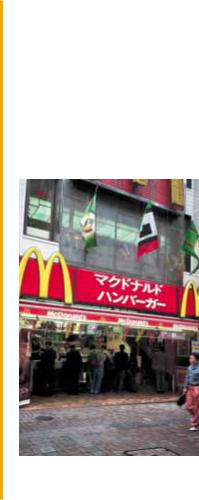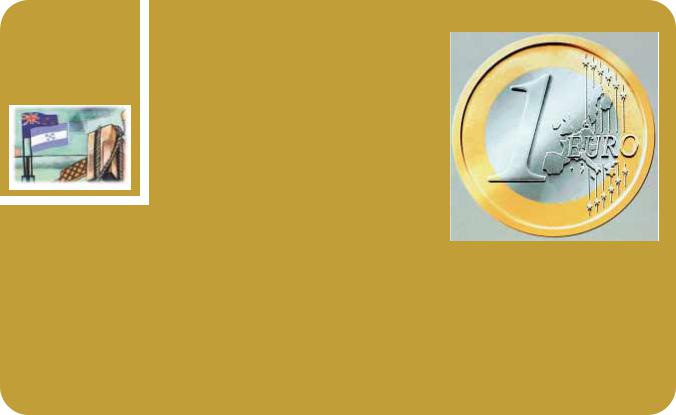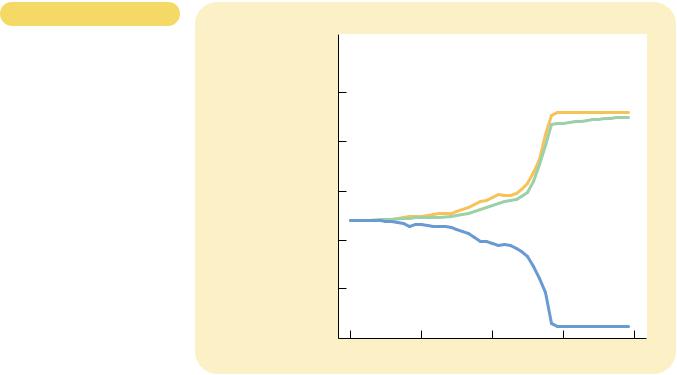
670 |
PART ELEVEN THE MACROECONOMICS OF OPEN ECONOMIES |
gives the answer. As another example, imagine that you are deciding whether to take a seaside vacation in Miami, Florida, or in Cancun, Mexico. You might ask your travel agent the price of a hotel room in Miami (measured in dollars), the price of a hotel room in Cancun (measured in pesos), and the exchange rate between pesos and dollars. If you decide where to vacation by comparing costs, you are basing your decision on the real exchange rate.
When studying an economy as a whole, macroeconomists focus on overall prices rather than the prices of individual items. That is, to measure the real exchange rate, they use price indexes, such as the consumer price index, which measure the price of a basket of goods and services. By using a price index for a U.S. basket (P), a price index for a foreign basket (P*), and the nominal exchange rate between the U.S. dollar and foreign currencies (e), we can compute the overall real exchange rate between the United States and other countries as follows:
Real exchange rate (e P)/P*.
This real exchange rate measures the price of a basket of goods and services available domestically relative to a basket of goods and services available abroad.
As we examine more fully in the next chapter, a country’s real exchange rate is a key determinant of its net exports of goods and services. A depreciation (fall) in the U.S. real exchange rate means that U.S. goods have become cheaper relative to foreign goods. This change encourages consumers both at home and abroad to buy more U.S. goods and fewer goods from other countries. As a result, U.S. exports rise, and U.S. imports fall, and both of these changes raise U.S. net exports. Conversely, an appreciation (rise) in the U.S. real exchange rate means that U.S. goods have become more expensive compared to foreign goods, so U.S. net exports fall.
QUICK QUIZ: Define nominal exchange rate and real exchange rate, and explain how they are related. If the nominal exchange rate goes from 100 to 120 yen per dollar, has the dollar appreciated or depreciated?
purchasing-power parity
a theory of exchange rates whereby a unit of any given currency should be able to buy the same quantity
of goods in all countries
A FIRST THEORY OF EXCHANGE-RATE DETERMINATION: PURCHASING-POWER PARITY
Exchange rates vary substantially over time. In 1970, a U.S. dollar could be used to buy 3.65 German marks or 627 Italian lira. In 1998, a U.S. dollar bought 1.76 German marks or 1,737 Italian lira. In other words, over this period the value of the dollar fell by more than half compared to the mark, while it more than doubled compared to the lira.
What explains these large and opposite changes? Economists have developed many models to explain how exchange rates are determined, each emphasizing just some of the many forces at work. Here we develop the simplest theory of exchange rates, called purchasing-power parity. This theory states that a unit of any given currency should be able to buy the same quantity of goods in all countries. Many economists believe that purchasing-power parity describes the forces that determine exchange rates in the long run. We now consider the logic on which this
F Y I
The Euro
CHAPTER 29 OPEN-ECONOMY MACROECONOMICS: BASIC CONCEPTS |
671 |
Some of the currencies mentioned in this chapter, such as the French franc, the German mark, and the Italian lira, are in the process of disappearing. Many European nations have decided to give up their national currencies and start using a new common currency called the euro. A newly formed European Central Bank, with representatives from all of the participating countries, issues
the euro and controls the quantity in circulation, much as the Federal Reserve controls the quantity of dollars in the U.S. economy.
Why are these countries adopting a common currency? One benefit of a common currency is that it makes trade easier. Imagine that each of the 50 U.S. states had a different currency. Every time you crossed a state border you would need to change your money and perform the kind of exchange-rate calculations discussed in the text. This would be inconvenient, and it might deter you from buying goods and services outside your own state. The countries of
Europe decided that as their economies became more integrated, it would be better to avoid this inconvenience.
There are, however, costs of choosing a common currency. If the nations of Europe have only one money, they can
have only one monetary policy. If they disagree about what monetary policy is best, they will have to reach some kind of agreement, rather than each going its own way. Because adopting a single money has both benefits and costs, there is debate among economists about whether Europe’s recent adoption of the euro was a good decision. Only time will tell what effect the decision will have.
long-run theory of exchange rates is based, as well as the theory’s implications and limitations.
THE BASIC LOGIC OF PURCHASING-POWER PARITY
The theory of purchasing-power parity is based on a principle called the law of one price. This law asserts that a good must sell for the same price in all locations. Otherwise, there would be opportunities for profit left unexploited. For example, suppose that coffee beans sold for less in Seattle than in Boston. A person could buy coffee in Seattle for, say, $4 a pound and then sell it in Boston for $5 a pound, making a profit of $1 per pound from the difference in price. The process of taking advantage of differences in prices in different markets is called arbitrage. In our example, as people took advantage of this arbitrage opportunity, they would increase the demand for coffee in Seattle and increase the supply in Boston. The price of coffee would rise in Seattle (in response to greater demand) and fall in Boston (in response to greater supply). This process would continue until, eventually, the prices were the same in the two markets.
Now consider how the law of one price applies to the international marketplace. If a dollar (or any other currency) could buy more coffee in the United States than in Japan, international traders could profit by buying coffee in the United States and selling it in Japan. This export of coffee from the United States to Japan
672 |
PART ELEVEN THE MACROECONOMICS OF OPEN ECONOMIES |
would drive up the U.S. price of coffee and drive down the Japanese price. Conversely, if a dollar could buy more coffee in Japan than in the United States, traders could buy coffee in Japan and sell it in the United States. This import of coffee into the United States from Japan would drive down the U.S. price of coffee and drive up the Japanese price. In the end, the law of one price tells us that a dollar must buy the same amount of coffee in all countries.
This logic leads us to the theory of purchasing-power parity. According to this theory, a currency must have the same purchasing power in all countries. That is, a U.S. dollar must buy the same quantity of goods in the United States and Japan, and a Japanese yen must buy the same quantity of goods in Japan and the United States. Indeed, the name of this theory describes it well. Parity means equality, and purchasing power refers to the value of money. Purchasing-power parity states that a unit of all currencies must have the same real value in every country.
IMPLICATIONS OF PURCHASING-POWER PARITY
What does the theory of purchasing-power parity say about exchange rates? It tells us that the nominal exchange rate between the currencies of two countries depends on the price levels in those countries. If a dollar buys the same quantity of goods in the United States (where prices are measured in dollars) as in Japan (where prices are measured in yen), then the number of yen per dollar must reflect the prices of goods in the United States and Japan. For example, if a pound of coffee costs 500 yen in Japan and $5 in the United States, then the nominal exchange rate must be 100 yen per dollar (500 yen/$5 100 yen per dollar). Otherwise, the purchasing power of the dollar would not be the same in the two countries.
To see more fully how this works, it is helpful to use just a bit of mathematics. Suppose that P is the price of a basket of goods in the United States (measured in dollars), P* is the price of a basket of goods in Japan (measured in yen), and e is the nominal exchange rate (the number of yen a dollar can buy). Now consider the quantity of goods a dollar can buy at home and abroad. At home, the price level is P, so the purchasing power of $1 at home is 1/P. Abroad, a dollar can be exchanged into e units of foreign currency, which in turn have purchasing power e/P*. For the purchasing power of a dollar to be the same in the two countries, it must be the case that
1/P e/P*.
With rearrangement, this equation becomes
1 eP/P*.
Notice that the left-hand side of this equation is a constant, and the right-hand side is the real exchange rate. Thus, if the purchasing power of the dollar is always the same at home and abroad, then the real exchange rate—the relative price of domestic and foreign goods—cannot change.
To see the implication of this analysis for the nominal exchange rate, we can rearrange the last equation to solve for the nominal exchange rate:
e P*/P.
CHAPTER 29 OPEN-ECONOMY MACROECONOMICS: BASIC CONCEPTS |
673 |
That is, the nominal exchange rate equals the ratio of the foreign price level (measured in units of the foreign currency) to the domestic price level (measured in units of the domestic currency). According to the theory of purchasing-power parity, the nominal exchange rate between the currencies of two countries must reflect the different price levels in those countries.
A key implication of this theory is that nominal exchange rates change when price levels change. As we saw in the preceding chapter, the price level in any country adjusts to bring the quantity of money supplied and the quantity of money demanded into balance. Because the nominal exchange rate depends on the price levels, it also depends on the money supply and money demand in each country. When a central bank in any country increases the money supply and causes the price level to rise, it also causes that country’s currency to depreciate relative to other currencies in the world. In other words, when the central bank prints large quantities of money, that money loses value both in terms of the goods and services it can buy and in terms of the amount of other currencies it can buy.
We can now answer the question that began this section: Why has the U.S. dollar lost value compared to the German mark and gained value compared to the Italian lira? The answer is that Germany has pursued a less inflationary monetary policy than the United States, and Italy has pursued a more inflationary monetary policy. From 1970 to 1998, inflation in the United States was 5.3 percent per year. By contrast, inflation was 3.5 percent in Germany, and 9.6 percent in Italy. As U.S. prices rose relative to German prices, the value of the dollar fell relative to the mark. Similarly, as U.S. prices fell relative to Italian prices, the value of the dollar rose relative to the lira.
CASE STUDY THE NOMINAL EXCHANGE RATE
DURING A HYPERINFLATION
Macroeconomists can only rarely conduct controlled experiments. Most often, they must glean what they can from the natural experiments that history gives them. One natural experiment is hyperinflation—the high inflation that arises when a government turns to the printing press to pay for large amounts of government spending. Because hyperinflations are so extreme, they illustrate some basic economic principles with clarity.
Consider the German hyperinflation of the early 1920s. Figure 29-3 shows the German money supply, the German price level, and the nominal exchange rate (measured as U.S. cents per German mark) for that period. Notice that these series move closely together. When the supply of money starts growing quickly, the price level also takes off, and the German mark depreciates. When the money supply stabilizes, so does the price level and the exchange rate.
The pattern shown in this figure appears during every hyperinflation. It leaves no doubt that there is a fundamental link among money, prices, and the nominal exchange rate. The quantity theory of money discussed in the previous chapter explains how the money supply affects the price level. The theory of purchasing-power parity discussed here explains how the price level affects the nominal exchange rate.
674 |
PART ELEVEN THE MACROECONOMICS OF OPEN ECONOMIES |
Figur e 29-3
MONEY, PRICES, AND THE
NOMINAL EXCHANGE RATE
DURING THE GERMAN
HYPERINFLATION. This figure
shows the money supply, the price level, and the exchange rate (measured as U.S. cents per mark) for the German hyperinflation from January 1921 to December 1924. Notice how similarly these three variables move. When the quantity of money started growing quickly, the price level followed, and the mark depreciated relative to the dollar. When the German central bank stabilized the money supply, the price level and exchange rate stabilized as well.
SOURCE: Adapted from Thomas J. Sargent, “The End of Four Big Inflations,” in Robert Hall, ed., Inflation (Chicago: University of Chicago Press, 1983), pp. 41–93.
Indexes |
|
|
|
|
(Jan. 1921 100) |
|
|
|
|
1,000,000,000,000,000 |
|
|
|
|
10,000,000,000 |
|
|
Money supply |
|
|
|
|
100,000 |
|
Price level |
|
|
|
|
|
|
1 |
|
|
|
|
.00001 |
|
Exchange rate |
|
|
|
|
|
|
.0000000001 |
|
|
|
|
1921 |
1922 |
1923 |
1924 |
1925 |
LIMITATIONS OF PURCHASING-POWER PARITY
Purchasing-power parity provides a simple model of how exchange rates are determined. For understanding many economic phenomena, the theory works well. In particular, it can explain many long-term trends, such as the depreciation of the U.S. dollar against the German mark and the appreciation of the U.S. dollar against the Italian lira. It can also explain the major changes in exchange rates that occur during hyperinflations.
Yet the theory of purchasing-power parity is not completely accurate. That is, exchange rates do not always move to ensure that a dollar has the same real value in all countries all the time. There are two reasons why the theory of purchasingpower parity does not always hold in practice.
The first reason is that many goods are not easily traded. Imagine, for instance, that haircuts are more expensive in Paris than in New York. International travelers might avoid getting their haircuts in Paris, and some haircutters might move from New York to Paris. Yet such arbitrage would probably be too limited to eliminate the differences in prices. Thus, the deviation from purchasing-power parity might persist, and a dollar (or franc) would continue to buy less of a haircut in Paris than in New York.
The second reason that purchasing-power parity does not always hold is that even tradable goods are not always perfect substitutes when they are produced in different countries. For example, some consumers prefer German beer, and others prefer American beer. Moreover, consumer tastes for beer change over time. If German beer suddenly becomes more popular, the increase in demand will drive up

CHAPTER 29 OPEN-ECONOMY MACROECONOMICS: BASIC CONCEPTS |
675 |
the price of German beer. As a result, a dollar (or a mark) might then buy more beer in the United States than in Germany. But despite this difference in prices in the two markets, there might be no opportunity for profitable arbitrage because consumers do not view the two beers as equivalent.
Thus, both because some goods are not tradable and because some tradable goods are not perfect substitutes with their foreign counterparts, purchasingpower parity is not a perfect theory of exchange-rate determination. For these reasons, real exchange rates fluctuate over time. Nonetheless, the theory of purchasing-power parity does provide a useful first step in understanding exchange rates. The basic logic is persuasive: As the real exchange rate drifts from the level predicted by purchasing-power parity, people have greater incentive to move goods across national borders. Even if the forces of purchasing-power parity do not completely fix the real exchange rate, they provide a reason to expect that changes in the real exchange rate are most often small or temporary. As a result, large and persistent movements in nominal exchange rates typically reflect changes in price levels at home and abroad.
CASE STUDY THE HAMBURGER STANDARD
When economists apply the theory of purchasing-power parity to explain exchange rates, they need data on the prices of a basket of goods available in different countries. One analysis of this sort is conducted by The Economist, an international newsmagazine. The magazine occasionally collects data on a basket of goods consisting of “two all beef patties, special sauce, lettuce, cheese, pickles, onions, on a sesame seed bun.” It’s called the “Big Mac” and is sold by McDonald’s around the world.
Once we have the prices of Big Macs in two countries denominated in the local currencies, we can compute the exchange rate predicted by the theory of purchasing-power parity. The predicted exchange rate is the one that makes the cost of the Big Mac the same in the two countries. For instance, if the price of a Big Mac is $2 in the United States and 200 yen in Japan, purchasing-power parity would predict an exchange rate of 100 yen per dollar.
How well does purchasing-power parity work when applied using Big Mac prices? Here are some examples from an Economist article published on April 3, 1999, when the price of a Big Mac was $2.43 in the United States:
|
PRICE OF |
PREDICTED |
ACTUAL |
COUNTRY |
A BIG MAC |
EXCHANGE RATE |
EXCHANGE RATE |
|
|
|
|
Italy |
4,500 lira |
1,852 lira/$ |
1,799 lira/$ |
Japan |
294 yen |
121 yen/$ |
120 yen/$ |
Russia |
33.5 rubles |
13.8 rubles/$ |
24.7 rubles/$ |
Germany |
4.95 marks |
2.04 marks/$ |
1.82 marks/$ |
Brazil |
2.95 reals |
1.21 reals/$ |
1.73 reals/$ |
Britain |
1.90 pounds |
0.78 pound/$ |
0.62 pound/$ |
You can see that the predicted and actual exchange rates are not exactly the same. After all, international arbitrage in Big Macs is not easy. Yet the two exchange rates are usually in the same ballpark. Purchasing-power parity is not
IN THE UNITED STATES THE PRICE OF A BIG MAC IS $2.43; IN JAPAN IT IS
294 YEN.

676 |
PART ELEVEN THE MACROECONOMICS OF OPEN ECONOMIES |
a precise theory of exchange rates, but it often provides a reasonable first approximation.
QUICK QUIZ: Over the past 20 years, Spain has had high inflation, and Japan has had low inflation. What do you predict has happened to the number of Spanish pesetas a person can buy with a Japanese yen?
CONCLUSION
The purpose of this chapter has been to develop some basic concepts that macroeconomists use to study open economies. You should now understand why a nation’s net exports must equal its net foreign investment, and why national saving must equal domestic investment plus net foreign investment. You should also understand the meaning of the nominal and real exchange rates, as well as the implications and limitations of purchasing-power parity as a theory of how exchange rates are determined.
The macroeconomic variables defined here offer a starting point for analyzing an open economy’s interactions with the rest of the world. In the next chapter we develop a model that can explain what determines these variables. We can then discuss how various events and policies affect a country’s trade balance and the rate at which nations make exchanges in world markets.
Summar y
Net exports are the value of domestic goods and services sold abroad minus the value of foreign goods and services sold domestically. Net foreign investment is the acquisition of foreign assets by domestic residents minus the acquisition of domestic assets by foreigners. Because every international transaction involves an exchange of an asset for a good or service, an economy’s net foreign investment always equals its net exports.
An economy’s saving can be used either to finance investment at home or to buy assets abroad. Thus, national saving equals domestic investment plus net foreign investment.
The nominal exchange rate is the relative price of the currency of two countries, and the real exchange rate is the relative price of the goods and services of two
countries. When the nominal exchange rate changes so that each dollar buys more foreign currency, the dollar is said to appreciate or strengthen. When the nominal exchange rate changes so that each dollar buys less foreign currency, the dollar is said to depreciate or weaken.
According to the theory of purchasing-power parity, a dollar (or a unit of any other currency) should be able to buy the same quantity of goods in all countries. This theory implies that the nominal exchange rate between the currencies of two countries should reflect the price levels in those countries. As a result, countries with relatively high inflation should have depreciating currencies, and countries with relatively low inflation should have appreciating currencies.
CHAPTER 29 OPEN-ECONOMY MACROECONOMICS: BASIC CONCEPTS |
677 |
|
Key Concepts |
|
|
|
|
closed economy, p. 658 |
nominal exchange rate, p. 668 |
open economy, p. 658 |
appreciation, p. 668 |
exports, p. 658 |
depreciation, p. 668 |
imports, p. 658 |
exchange rate, p. 669 |
net exports, p. 658 |
purchasing-power parity, p. 670 |
Questions for Review
1.Define net exports and net foreign how and why they are related.
2.Explain the relationship among net foreign investment.
3.If a Japanese car costs 500,000 car costs $10,000, and a dollar the nominal and real exchange
logic behind the theory of parity.
printing large quantities of U.S. happen to the number of Japanese
buy?
Problems and Applications
1.How would the following transactions affect U.S. exports, imports, and net exports?
a.An American art professor spends the summer touring museums in Europe.
b.Students in Paris flock to see the latest Arnold Schwarzenegger movie.
c.Your uncle buys a new Volvo.
d.The student bookstore at Oxford University sells a pair of Levi’s 501 jeans.
e.A Canadian citizen shops at a store in northern Vermont to avoid Canadian sales taxes.
2.International trade in each of the following products has increased over time. Suggest some reasons why this might be so.
a.wheat
b.banking services
c.computer software
d.automobiles
3.Describe the difference between foreign direct investment and foreign portfolio investment. Who is more likely to engage in foreign direct investment—a corporation or an individual investor? Who is more likely to engage in foreign portfolio investment?
4.How would the following transactions affect U.S. net foreign investment? Also, state whether each involves direct investment or portfolio investment.
a.An American cellular phone company establishes an office in the Czech Republic.
b.Harrod’s of London sells stock to the General Electric pension fund.
c.Honda expands its factory in Marysville, Ohio.
d.A Fidelity mutual fund sells its Volkswagen stock to a French investor.
5.Holding national saving constant, does an increase in net foreign investment increase, decrease, or have no effect on a country’s accumulation of domestic capital?
6.The business section of most major newspapers contains a table showing U.S. exchange rates. Find such a table and use it to answer the following questions.
a.Does this table show nominal or real exchange rates? Explain.
b.What are the exchange rates between the United States and Canada and between the United States and Japan? Calculate the exchange rate between Canada and Japan.
c.If U.S. inflation exceeds Japanese inflation over the next year, would you expect the U.S. dollar to appreciate or depreciate relative to the Japanese yen?
7.Would each of the following groups be happy or unhappy if the U.S. dollar appreciated? Explain.









